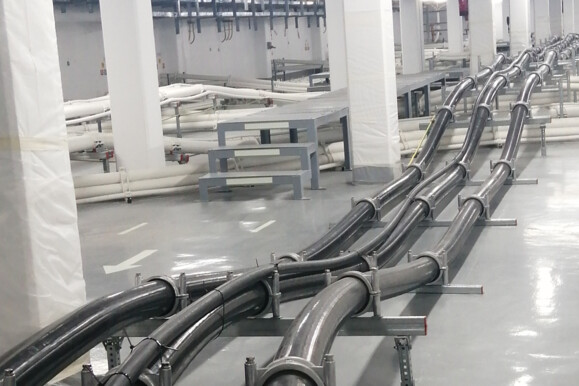Project Overview
The data center facility in this case study has evolved and is currently designed and built to operate as a modern colocation data center. New bus ducts were fitted to the facility; low ampacity bus ducts can range from an ampacity of 630A to 2000A, depending on the data center designer and are commonly known as distribution or fitout busducts. The data center operator pursued a retrofit bus duct temperature monitoring solution, which would increase operational efficiency and provide a continuous monitoring solution for the entire length of all bus duct sections in the data halls.
One challenge with colocation facilities is the need to occasionally relocate server cabinets due to facility upgrades, reorganization of space, or space constraints. This situation can disturb the stable electrical powering arrangement of distribution bus ducts and may cause overheating. It is typical to use thermography services to check the bus duct infrastructure before, during, and after server cabinet relocation. However, manual thermography services require physical access and use a handheld instrument that may capture inconsistent temperature measurements. AP Sensing’s Distributed Temperature Sensing (DTS) solution alleviates these challenges in addition to providing continuous, 24/7 temperature monitoring.
Solution
AP Sensing collaborated with a local partner over multiple phases to deploy a distributed fiber optic sensing solution for the data center. Each phase deployed one DTS device with four channels, each device monitors up to 2 km per channel. Our speciality fiber optic sensor cable was fitted along the bus ducts using customized cable clips. For this data center, all DTS units were rack mounted and fitted within one available rack cabinet. Simplified electrical power, a data connection, and fiber optic pigtail management are all self-contained in this rack cabinet. Our DTS solution is configured for Modbus TCP/IP communication and achieved seamless integration with the end client’s operation center. For each DTS unit at the facility, AP Sensing configured up to 256 zones per channel. After full deployment, multiple units monitoring the full bus duct infrastructure allow easy visualization and complete analysis of the entire infrastructure. In the event of an alarm, the system automatically pinpoints points of interest for future investigation.
Advantages
Continuous, real-time bus duct monitoring enables early detection of hotspots or other potential issues, enabling proactive maintenance, reduced downtime, and planning of server rack relocation. DTS improves overall facility safety by reducing electrical failures or fires associated with bus duct malfunctions, and reduces maintenance costs by eliminating manual monitoring services and allowing for targeted repairs or replacements rather than a reactive intervention after a failure occurs. With real-time, remote data, facility managers can access data from any location, facilitating rapid decision making and troubleshooting. Lastly, access to large amounts of monitoring data over time enables operators to identify trends, optimize operations, and predict future maintenance needs.
Conclusion
The end client requested a comparison of temperature measurements made with our DTS vs. traditional thermography during stress testing of the bus duct infrastructure. In the end, the client was impressed by the consistency of the DTS temperature measurements and the ease of obtaining the data. Our DTS ensures bus duct health during the physical relocation of collocated server racks in this facility, enabling easier planning, execution and monitoring. Additionally, fiber optic DTS allows for 24/7 bus duct monitoring, early detection of hotspots or potential issues, and eliminates the need for costly traditional thermography services.





